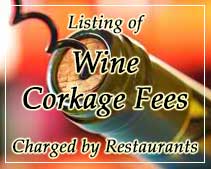About Sangiovese Wine Grape
Philippines wine supplier Manila wine shop discusses wine by the grape variety Sangiovese.
Date: October 4, 2010
Italian immigrants from Tuscany probably introduced the Sangiovese grape to California in the late 1800s, possibly at the Segheshio Family’s “Chianti Station,” near Geyserville. It is one of several varietal components of the field blend in many old North Coast and Gold Country vineyards that are often otherwise identified as Zinfandel.
Sanguis Jovis, the Latin origin for the varietal name, literally means “blood of Jove” and it is likely that Sangiovese (a.k.a. Sangioveto or San Gioveto) was known by Etruscan winemakers, although the first literary reference to it was in 1722. It is probably indigenous to Tuscany, whose most famous wine is Chianti.
The basic blend of Chianti was established by Baron Ricasoli in the 1890s. This averages 70% sangiovese as the varietal base (along with 15% canaiolo [red], and 15% trebbiano [white] and sometimes a little colorino [red]). Many vineyards are traditionally planted with this varietal mix. It is difficult even for the Italians to keep up with their own ever-changing and very detailed wine laws, which specify permitted grape types, maximum yields per acre, minimum alcohol content, minimum aging standards before sale, etc. Currently, the minimum amount of sangiovese permitted in Chianti is 90%. Other grapes that may be used now include malvasia toscana, a white grape far superior to the ubiquitous trebbiano. Still, the total white grapes used must not exceed 5% of the blend.
In some ways sangiovese is to Chianti as cabernet sauvignon is to Bordeaux. Both form the base of wines normally blended with other varietals and both by themselves share a certain distinctive elegance and complexity, when well-made.
There are at least 14 separate and distinct clones of sangiovese. At one point, there was some attempt in Italy to identify two separate “families”, Grosso and Piccolo, although this seemed to have more commercial basis (“mine’s better than yours”) than ampelographic or taste evidence to justify this attempt to classify.
The fruit is slow to mature and late-ripening. With relatively thin skins, it has a tendency to rot in dampness and does not mature well if planted above an elevation of 1,500 feet. Sangiovese vineyards with limestone soil seem to produce wines with more forceful aromas.
The hot, dry climate, such as Tuscany provides, is where sangiovese thrives. Because these climatic criteria generally enhance quantity, rather than quality, it takes careful cultivation and winemaking techniques to produce really excellent wine from this grape. The official classification of Chianti itself demonstrates the widely fluctuating range of Sangiovese quality from those identified as ordinary vino di tavola to the highest classico superiore. Sangiovese is the #1 varietal in Italy with 247,000 acres, 10% of the entire wine grape crop.
The flavor profile of Sangiovese is fruity, with moderate to high natural acidity and generally a medium-body ranging from firm and elegant to assertive and robust and a finish that can tend towards bitterness. The aroma is generally not as assertive and easily identifiable as Cabernet Sauvignon, for example, but can have a strawberry, blueberry, faintly floral, violet or plummy character.
Source: http://www.winepros.org/wine101/grape_profiles/sangiovese.htm
Although wines are widely available in most Asian countries, especially in Hong Kong which has eliminated import tariff on wines altogether, the availability of fine vintage wines is still very scarce. Most wine merchants offer big names, young vintages and cheaper wines for everyday consumption. Wine lovers and connoisseurs looking for something special often travel to Clark Pampanga Philippines to do their shopping at this Wine Shop in Manila.
At Yats Wine Cellars we believe that a little bit of knowledge in wine goes a long way to developing expectations in the wines we choose to buy or drink. Without expectation, it is difficult to really enjoy wine to its fullest. With this in mind, efforts are made by Yats Wine Cellars to make it as easy and enjoyable as possible for our clients to learn more about wine.
Birthday wine gifts is one of the most popular birthday gifts to give someone living in the Philippines. Fine Vintage wine from Yats Wine Cellars is a sure winner and it does not have to cost a great deal to send someone a bottle in Philippines
To avail of wine catering service of Yats Wine Cellars, just contact this wine supplier in Manila or Angeles Clark Philippines for a meeting to design a theme for the event. The venue for a wine event can be in the privacy of a home, the convenience of an office in Manila for example or in a clubhouse of a subdivision. Wine glasses and accessories necessary for wine service are included in the wine catering service. Moreover, interesting wine notes accompany the wine to help participants enjoy the event even more by learning a little bit about wine while enjoying the party. A wine steward will be present to serve the wine.
There is also an exciting collection of white wine from Burgundy at this wine shop in Clark Pampanga such as Meursault, Chablis, Chassagne Montrachet, Puligny Montrachet, Corton-Charlemagne and St. Aubin. Red wines from Burgundy, Bordeaux and Rhone are also available with a good depth of back vintages too. Visitors buy wine in Manila and Pampanga should not miss stopping at this wine shop for a few bottles of fine vintage wines to bring home.
http://www.ClarkWineCenter.com
Getting to this wine shop in Pampanga Angeles City Clark Freeport Zone Philippines from Manila
Getting to the Clark Wine Center wine shop from Manila is quite simple: after entering Clark Freeport from Dau and Angeles City, proceed straight along the main highway M A Roxas. Clark Wine Center is the stand-along white building on the right, at the corner A Bonifacio Ave. From the Clark International Airport DMIA, ask the taxi to drive towards the entrance of Clark going to Angeles City. From Mimosa, just proceed towards the exit of Clark and this wine shop is on the opposite side of the main road M A Roxas.
Clark Wine Center
Bldg 6460 Clark Observatory Building
Manuel A. Roxas Highway corner A Bonifacio Ave,
Angeles Clark Freeport Zone, Pampanga 2023
0922-870-5173 0917-826-8790 (ask for Ana Fe)
YATS Wine Cellars
Manila Sales Office
3003C East Tower, Phil Stock Exchange Center,
Exchange Rd Ortigas Metro Manila, Philippines 1605
(632) 637-5019 0917-520-4393 ask for Rea or Chay
Best place to buy wine in Clark Pampanga outside Manila near Subic and Angeles City Philippines is Clark Wine Center.
You can skip to the end and leave a response. Pinging is currently not allowed.







